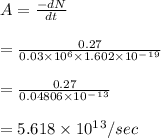
Physics, 28.06.2020 07:01 maysahdabest
A person with lymphoma receives a dose of 45 Gy in the form of γ radiation during a course of radiotherapy. Most of this dose is absorbed in 18 g of cancerous lymphatic tissue. (a) How much energy is absorbed by the cancerous tissue? (b) If this treatment consists of five 20 minute sessions per week over the course of 5 weeks and just 1% of the γ photons in the γ ray beam are absorbed, what is the power of the γ ray beam? (c) If the γ ray beam consists of just 0.5% of the γ photons emitted by the γ source, each of which has energy of 0.03MeV, what is the activity (in Ci) of the γ ray source?

Answers: 3
Another question on Physics

Physics, 22.06.2019 12:00
You have a resistor and a capacitor of unknown values. first, you charge the capacitor and discharge it through the resistor. by monitoring the capacitor voltage on an oscilloscope, you see that the voltage decays to half its initial value in 2.70 miss . you then use the resistor and capacitor to make a low-pass filter. what is the crossover frequency fc?
Answers: 2

Physics, 22.06.2019 15:40
Question 1 what is amperage? is the rate of doing work. is the rate of flow of protons in electric current. represents the amount of pressure behind electron flow. is the rate of flow of electrons in electric current. 2 points question 2 what is voltage? is the rate of doing power. represents the amount of pressure behind electron flow. is the rate of doing work. is the rate of flow of electrons in electric current. 2 points question 3 what is power? is the rate of flow of protons in electric current. is the rate of flow of electrons in electric current. is the rate of doing work. represents the amount of pressure behind electron flow. 2 points question 4 if we multiply volts times amps we get what? power circuit work current 2 points question 5 what are two ways alternating currents are similiar? in both ac and dc electrons flow in the same pattern. in both ac and dc, the flow of electrons changes directions back and forth. both ac and dc are only possible in certain materials with atoms that will allow electron flow. both ac and dc involve the flow of electrons. 4 points question 6 how does the flow of electrons flow in an alternating current? the flow of electrons is always slower in an alternating current than within a direct current. the flow of electrons is not constant and forward; it changes direction back and forth. electrons flow from from a higher affinity to that of a lower affinity. electron flow is constant and only in a forward direction. 2 points question 7 what is the flow like in a direct current? the flow of electrons is not constant and forward; it changes direction back and forth. the flow of electrons is constant and only in a forward direction. the flow of electrons go from a higher affinity to a lower affinity. the flow of electrons are always faster in a direct current. 2 points question 8 how is an electric current able to flow? electrons flow from the higher affinity to lower affinity and electrical current is generated. protons flow from the higher affinity to lower affinity and electrical current is generated. the movement of protons from one atom to another leads to an electric charge. the movement of electrons from one atom to another atom in a line results in a flow of electric current. 2 points question 9 how do electrons move from the two different types of metal in a battery? protons flow from the metal with the lower affinity to the metal with higher affinity and electrical current is generated. electrons flow from the metal with the lower affinity to the metal with higher affinity and electrical current is generated. electrons flow from the metal with the higher affinity to the metal with lower affinity and electrical current is generated. protons flow from the metal with the higher affinity to the metal with lower affinity and electrical current is generated.
Answers: 2

Physics, 22.06.2019 20:50
In a game of pool, ball a is moving with a velocity v0 of magnitude v0 = 15 ft/s when it strikes balls b and c, which are at rest and aligned as shown. knowing that after the collision the three balls move in the directions indicated and assuming frictionless surfaces and perfectly elastic impact (that is, conservation of energy), determine the magnitudes of the velocities va, vb, and vc.
Answers: 3

Physics, 22.06.2019 21:10
Which of the following is a measure of the amount of light a star directly emits? a. luminosity b. intensity c. wavelength d. brightness
Answers: 2
You know the right answer?
A person with lymphoma receives a dose of 45 Gy in the form of γ radiation during a course of radiot...
Questions


Mathematics, 09.06.2021 23:40


Physics, 09.06.2021 23:40





Physics, 09.06.2021 23:40




English, 09.06.2021 23:40




Engineering, 09.06.2021 23:40

Mathematics, 09.06.2021 23:40

Mathematics, 09.06.2021 23:40











